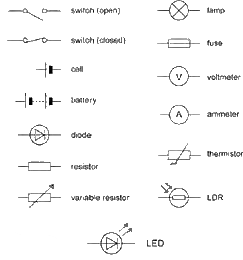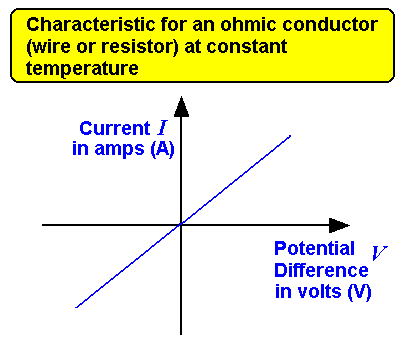P2.3.2 |
Electrical circuits |
a) Electric current is a flow of electric charge. The size of the electric current is the rate of flow of electric charge. The size of the current is given by the equation:
I = Q /t |
I is the current in amperes (amps), A
Q is the charge in coulombs, C
t is the time in seconds, s
|
b) The potential difference (voltage) between two points in an electric circuit is the work done (energy transferred) per coulomb of charge that passes between the points.
V = W/Q |
Teachers can use either of the terms potential difference or voltage but questions will be set using the term potential difference.
Candidates will gain credit for the correct use of either term.
V is the potential difference in volts, V
W is the work done in joules, J
Q is the charge in coulombs, C |
c) Circuit diagrams using standard symbols. The following standard symbols should be known:

|
Candidates will be required to interpret and draw circuit diagrams.
Knowledge and understanding of the use of thermistors in circuits, eg thermostats is required.
Knowledge and understanding of the applications of light-dependent resistors (LDRs) is required, eg switching lights on when it gets dark. |
d) Current–potential difference graphs are used to show how the current through a component varies with the potential difference across it. |
See characteristic curves |
e) The current–potential difference graphs for a resistor at constant temperature.

|
f) The resistance of a component can be found by measuring the current through, and potential difference across, the component. |
Need to know that you use an ammeter in series with the component and voltmemer in parallel with it. |
g) The current through a resistor (at a constant temperature) is directly proportional to the potential difference across the resistor. |
See the graph for (e) |
h) Calculate current, potential difference or resistance using the equation:
V = I x R |
V is the potential difference in volts, V
I is the current in amperes (amps), A
R is the resistance in ohms, Ω |
| i) The current through a component depends on its resistance. The greater the resistance the smaller the current for a given potential difference across the component. |
|
j) The potential difference provided by cells connected in series is the sum of the potential difference of each cell (depending on the direction in which they are connected). |
|
k) For components connected in series:
■ the total resistance is the sum of the resistance of each component
■ there is the same current through each component
■ the total potential difference of the supply is shared between the components. |
|
l) For components connected in parallel:
■ the potential difference across each component is the same
■ the total current through the whole circuit is the sum of the currents through the separate components. |
|
| m) The resistance of a filament bulb increases as the temperature of the filament increases. |
HT only Candidates should be able to explain resistance change in terms of ions and electrons. |
| n) The current through a diode flows in one direction only. The diode has a very high resistance in the reverse direction. |
|
| o) An LED emits light when a current flows through it in the forward direction. |
Candidates should be aware that there is an increasing use of LEDs for lighting, as they use a much smaller current than other forms of lighting |
| p) The resistance of a light-dependent resistor (LDR) decreases as light intensity increases. |
|
| q) The resistance of a thermistor decreases as the temperature increases. |
Knowledge of a negative temperature coefficient thermistor only is required. |


